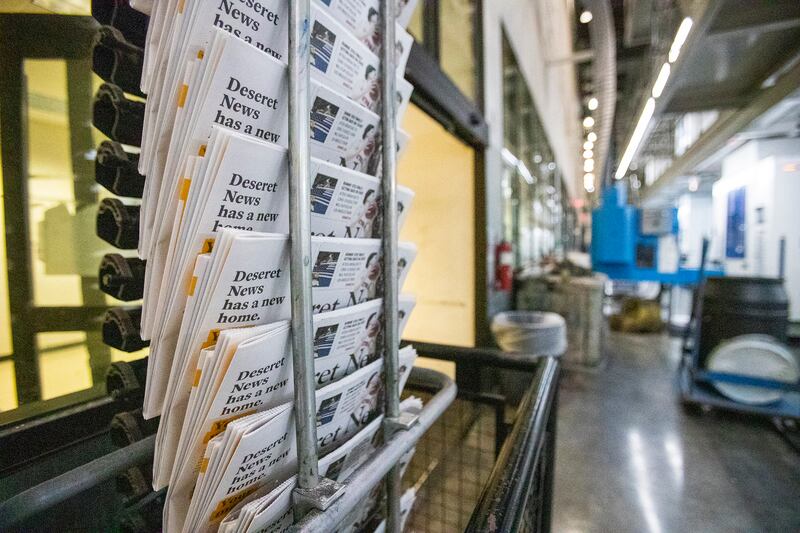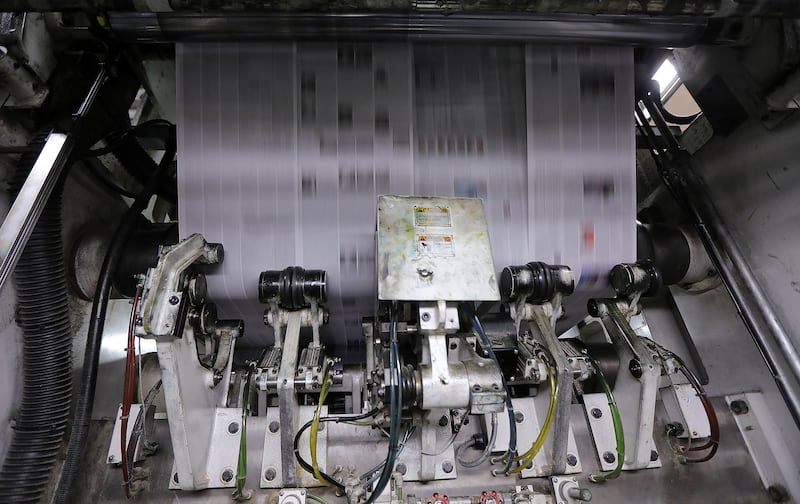SALT LAKE CITY — In a way, you could say we’ve come full circle.
This weekend, when the Deseret News print edition moves from daily on-your-porch or in-the-bushes home delivery to a weekly print edition by mail, it will be like rounding a corner into the past, albeit with a healthy dose of daily digital delivery.
Back in June of 1850, when the Deseret News first opened for business, the newspaper also came out once a week, on the weekend, and nobody delivered that to your door either.
Of course a lot has happened in the news business over the past 170 years that has led to this momentous development. Almost all of it good. Try to imagine the reaction of the first subscribers to the Deseret News — who paid $2.50 for a six-month subscription so they could come to the shop where the paper was printed and quite literally grab a copy hot off the presses — seeing that now you can get it on your phone! For free!

But with change, however great and inevitable, comes nostalgia. In this case, fond reflections on a newspaper-turned-website that qualifies as a bona fide state fixture: The Deseret News is by far the oldest continuously operating business in Utah and will continue to be. It was started less than three years after the first wagon train wound its way into the Salt Lake Valley.
The first settlers had their life-and-death reasons for leaving Illinois and venturing 1,000 miles from civilization, but wanting to get away from the news wasn’t one of them.
Fortunately, they brought a printing press with them: a 2-ton piece of iron that it took two years and six yoke of oxen to get here from Boston. At first the hand press was used to “print up literature pertaining to the provisional state of Deseret.” But Willard Richards, a member of the First Presidency of The Church of Jesus Christ of Latter-day Saints and a leader in the new community, was a wordsmith and newsman at heart.

“We propose to publish a small weekly sheet, as large as our local circumstances will permit, to be called ‘Deseret News,’” Richards explained in his prospectus for the new enterprise. The content, he further explained, would include “everything that may fall under our observation, which may tend to promote the best interest, welfare, pleasure and amusement of our fellow citizens.”
Great Salt Lake City had its first newspaper. The first issue, the size of a small handbill, contained 18 columns; 11 of which dealt with politics in Washington.
All this information is covered in “Voice in the West,” a book written by Wendell Ashton that was published in 1950 on the 100-year anniversary of the Deseret News.
Ashton, who would become a Deseret News publisher in the 1970s, spells out how it was no easy task putting out a newspaper in the early going. Paper, for one thing, was hard to come by. For years, the newspaper solicited old rags and used articles of clothing in order to make “homemade paper” that was only marginally better than nothing. Thus, it was possible for a subscriber to read all about it on a shirt he’d donated to the cause. Sometimes the news was as old as the shirt.
Slowly but surely, though, things improved. In 1860 the Pony Express greatly enhanced news-gathering by speeding up mail delivery from the East, followed in 1861 by the transcontinental telegraph that sped it up even more (and rendered the Pony Express a one-year wonder). Then in 1869 came the transcontinental railroad, flattening the Earth.
The Deseret News reacted to all this progress by expanding its coverage, increasing its circulation, printing every day instead of weekly (the first daily edition was in 1867), and on much better paper.

On or about 1900, classified ads were introduced, producing a revenue stream that pleased the accounting department. In 1920, the year of the first radio broadcast in America, the Deseret News showed its penchant for embracing new technology by forming a Wireless Club, sending news flashes by Morse Code to club members on their shortwave radios — a forerunner of what we call “online” today. In 1922 the newspaper acquired a license to start a radio station, KZN, that later became KSL.
By the time it turned 100 in 1950 the Deseret News had covered four major wars — Civil, Spanish-American, World War I, World War II — reported on the end of slavery and Jackie Robinson’s first game as a Brooklyn Dodger, and watched the invention of the incandescent light bulb, the telephone, the bicycle, the automobile, the airplane, radio, television and, not incidentally, the linotype machine.
In the final chapter of “Voice in the West,” Wendell Ashton took a minute to marvel at the progress the century had wrought:
“The Deseret News, the people’s paper, had recorded the mighty steps in man’s mechanical progress,” he wrote. “One hundred years later, foreign copy, including pictures, flashed into the newsrooms from various parts of the world in seconds. News pressmen worked with monstrous machines that in a matter of minutes turned out more newspaper copies than had been issued in an entire year in the beginning.”
At that, it was just warming up.

More innovation
In 2000, another Deseret News biography was produced, this time to commemorate 150 consecutive years of publishing. Twila Van Leer was one of the authors of “Through Our Eyes.” She remembers the enterprise as both “invigorating” and “daunting” as she worked with Don Woodward, Carma Wadley and Bob Noyce to give proper voice to “all that weight of history.”
Today, at 87, Twila is as young at heart as she was when she walked into the Deseret News doors at 18 and asked for a job.
It was the summer of 1951. She was the personification of ignorance-is-bliss. She’d just graduated from high school in Pioche, Nevada, and made her way to the big city to become a journalist. Fortunately, there was an opening for a copy girl. She was promoted to writing obits within a year, then to full-fledged reporter. Nearly 70 years later, she still on occasion contributes her inimitable prose to the Deseret News.
From her unique vantage point from the 1950s onward, Twila — whose career leapt from manual typewriters to electronic typewriters to laptop computers — looks back on a Deseret News that kept getting better, but quieter.
“In the ’50s, one of the things I loved about the newsroom is how noisy it was,” she said. “You had the teletype machines, you had the presses going, the phones ringing all the time, people shouting, yelling ‘Copy,’ of course the old typewriters clacking away. There was just something about the music of the newsroom that was fascinating to me.
“As time went on, the more technology we got, the quieter it got.”
Home delivery began in the 1940s and 1950s. So did the advent of coin-operated newspaper stands on downtown street corners, putting the newsboys who’d owned those corners for decades either out of business or onto their bikes on newly formed paper routes in the suburbs, trying to miss the flower beds.
By now, newspapers had become a part of the news choir, as opposed to always leading the chorus. Television and radio could break stories faster. In 1935, when Will Rogers died in a plane crash, the Deseret News rushed an EXTRA onto the streets that sold 30,000 papers in just hours. In 1963, when President John F. Kennedy was assassinated, the news event of the century, the edition that was rushed to the streets sold considerably less. The Deseret News wouldn’t publish another EXTRA until the rescue of Elizabeth Smart in 2003.
In the 1970s and 1980s the emphasis switched to in-depth, investigative journalism, a la Woodward and Bernstein, and to long-form feature stories and expanded sports and women’s sections. This was papers showing off; doing what they did best. At the Deseret News, readership grew as its footprint expanded geographically as well as editorially.
Rick Hall watched this “golden age of journalism” unfold during his 45-year tenure at the Deseret News that began in 1970. His career, like Twila Van Leer’s, started when he was still a teenager.
Hall was a student at Kearns High School when he was hired as a copy boy. His first writing assignment was as a high school stringer, covering football and basketball games. After continuing to work at the paper while getting his degree at the University of Utah, he eventually went into management and served as city editor and managing editor until his retirement in 2015.
“We had a bureau in Washington, D.C.; in Davis County; in Utah County; we had stringers (correspondents) all around the state and into parts of adjoining states,” he said, recalling the era of growing coverage.
Hall saw the first computers come on the scene (in 1983), followed by the emergence of “a little thing called the internet.” He watched as journalists recognized and ultimately embraced the technology that could enhance their jobs. To this day, Hall speaks with wonder of the time he successfully filed a 1,500-word story from a hotel room in Vienna, returning from a U.N.-sponsored trip to the Holy Land, on his Radio Shack TRS-80 — early laptops known to reporters as Trash 80s.
“I hooked up the telephone couplers, punched in about 80,000 numbers into the telephone, and it worked!” he said. “I couldn’t believe it. It was a miracle.”
Little did he know it was just the start of a technology revolution.
The immediacy, ease and reach of computers and the innovations brought by the internet brought both opportunity and challenge to the world of newspapers which continues. Over time, said Hall, “We all began to realize there’d be a day we’d quit printing on dead trees.”
Paper will live on in the mail version that debuts this weekend — with in-depth coverage that readers can take some time with, putting their phones at their side and sifting the sections through their hands.
Include Twila Van Leer in that company. “There’s something about the tactile thing, about having something you can pick up and see more than once if you want to,” she said. She’ll still get that on the weekend. As for the rest of the week, “I’m going to have to learn how to read the online version,” she said.
In addition, Deseret News readers will receive a new monthly in-depth magazine called Deseret which will debut in January. Change means growth, and it’s growth that stretches far beyond that weekly start in 1850.
“We are in a unique position because for years now our digital readership has dwarfed our print readership and the great majority of the remaining print readers have become digital first,” said Jeff Simpson, president and publisher of the Deseret News. There are nearly 500 times the number of digital users on Deseret.com than local print subscribers.
Added Deseret News Editor Doug Wilks: “Change is never easy, particularly when you’re changing a readership habit. But our commitment to providing a strong news report with fresh commentary, analysis and opinion remains constant. We hope those who have yet to discover the Deseret News online will join us everyday, and take a few minutes on the weekend to grab that print edition and spend some time with it.”






















Correction: An earlier version said home delivery began in the 1950s but actually began in the 1940s and 1950s.


 alt=Lee Benson
alt=Lee Benson


















